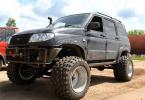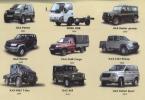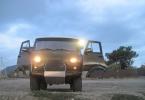In addition to the division into main and auxiliary, marine engines are distinguished by the number of strokes that make up the working cycle. Stroke is understood as the working processes in the engine cylinder, performed during one piston stroke (up or down). A full working cycle can be carried out in four strokes - four-stroke engines (four piston strokes or two crankshaft revolutions) and in two strokes - two-stroke engines (two piston strokes or one crankshaft revolution).
According to the method of forming a mixture of fuel with air necessary for combustion, engines with internal and external mixture formation are distinguished. Internal mixture formation occurs in the cylinders of diesel engines due to the mixing and evaporation of the finely atomized fuel injected by the nozzle in a high-temperature compressed air environment. External mixture formation is mainly inherent in engines running on light grades of liquid fuel. These engines use a special device to form a fuel-air mixture - a carburetor. Therefore, they are also called carburetor. Four- and two-stroke carburetor engines are often used in small boats, lifeboats, and crew boats as engines for stationary and outboard motors.
On river vessels, engines with vertical single-row arrangement of cylinders and V-shaped engines are used (on motor ships of the "Raketa" and "Meteor" type). The outboard motor cylinders are horizontal.
GOST 4393-74 establishes requirements for the main types and parameters of diesel engines, depending on the average effective pressure and speed. These requirements apply to both in-line, V-shaped, twin-row and radial diesel engines. According to this GOST, stationary, ship, locomotive and industrial diesel engines of the indicated modifications with a rotational speed from 3000 to 100 rpm, a cylinder capacity from 8 to 4630 oe. l. with. and an average effective pressure from 4.7 to 20 kgf / cm2 are divided into 24 types.
The direction of rotation of the crankshaft is also considered a classification. If you look at the engine from the side of the energy consumer, the crankshaft will rotate counterclockwise for the left (left-hand model) engine, and clockwise for the right-hand model. In the passports of engines of foreign brands, the reverse direction of rotation may be indicated.
There are other classifications as well. Some of them are reflected in the engine markings.
In accordance with GOST 4393-74, ship, stationary, diesel and industrial engines are designated by letters and numbers.
The first digit indicates the number of cylinders, the last digits indicate the diameter and, through a fraction, the piston stroke in centimeters. The letters between the numbers denote: H - four-stroke, D - two-stroke, P - reversible (the direction of rotation of the crankshaft changes), C - ship's non-reversible (the direction of rotation of the crankshaft does not change, but the direction of rotation of the propeller shaft is changed using a special reversible clutch ), The P-engine has a reduction gear from the crankshaft to the propeller shaft, which reduces the speed, H is a supercharged engine (a fresh charge of air is supplied under a certain excess pressure). There are other designations: DD - double-acting two-stroke engine, K - crosshead, but such engines are not used on river ships. At the end of the brand, after the fractional number, a digit may be placed indicating the engine modification.
Do not confuse the designation according to GOST with the factory mark ("name"). So, for example, the 6CHRN 36/45 engine has a factory brand G70; engine 3D6 according to GOST is designated as 6ChSP 15/18; the M400 engine has a symbol according to GOST 12CHSN 18/20, etc.
There is a unified marking system for marine compressorless diesel engines. The brand of the engine determines its basic design features. The letters used for marking mean: Ч - four-stroke; D - two-stroke; DD - two-stroke double action; Р - reversible; С - shipboard with reversible clutch; P - with a reduction gear; K - crosshead; H - supercharged.
The numbers indicate: the first is the number of cylinders; the number above the line is the cylinder diameter in centimeters, below the line is the piston stroke in centimeters; the last figure is the order of the engine upgrade.
The absence of the letter K in the brand means that the diesel is trunk (cross-head); if the letter P is absent, the diesel is irreversible.
Let's consider examples of marking and brief characteristics of modern domestic marine diesel engines.
Diesel 6CHRN 36/45 is a six-cylinder, four-stroke, single-action, trunk, vertical, reversible gas-turbine supercharged engine with a cylinder diameter of 36 cm and a piston stroke of 45 cm.It is used as a main marine engine with direct connection to a propeller shaft or through a reduction gear. Rated power 900 and 1200 ehp, shaft speed 375 rpm; Supercharging is carried out by a TK-30 turbocharger with intercooling of the charge air.
Diesel engine CHN 26/26 - four-stroke single-action, with V-shaped arrangement of cylinders, with an undivided combustion chamber, non-reversible, high-speed, with gas turbine supercharging; used as the main marine engine; can be twelve-cylinder with a power range from 900 to 3000 e.h.p. and sixteen-cylinder with a power range from 1200 to 4000 ehp. at a shaft rotation frequency from 500 to 1000 rpm.
Diesel DRN 30/50 - two-stroke, low-speed, reversible, with an undivided combustion chamber; available in four, six and eight cylinders with direct power transmission to the propeller shaft; The valveless cross-flow of the cylinders is performed by a piston-type purge pump. Supercharging is a combined two-stage: at the first stage, it is carried out by a turbocharged compressor, the turbine of which runs on diesel exhaust gases, and at the second stage - by a driven piston pump. The nominal power of the diesel engine is 750 ehp, the shaft speed is 300 rpm, the charge air pressure is 147 kn / m 2 (1.5 kgf / cm 2).
Diesel 6DR 39/45 (factory mark 37D) - six-cylinder, two-stroke, reversible, high-speed, with a direct-flow valve purge system and an undivided combustion chamber. It has a power of 2000 ehp, a shaft speed of 500 rpm. The blowdown pump is a jet, three-bladed, positive displacement pump.
Diesel 7DKRN 74/160 - seven-cylinder, two-stroke, crosshead, low-speed, reversible, supercharged. Built in the USSR under the license of the Burmeister and Vine plant. Installed on ships as the main engine with direct power transmission to the propeller shaft. The rated power of the engine is 8750 ehp, the shaft rotation speed is 115 rpm. The purging system is single-flow valve with the exhaust gases being released through one valve in the cylinder head. The pressurization is carried out by centrifugal compressors driven by pulse gas turbines. The charge air pressure is about 140 kn / m 2 (1.4 kgf / cm 2). The fuel system of the engine is designed in such a way that it can run on diesel and boiler fuel.
Internal combustion engines are classified according to the following main characteristics:
By appointment - main and auxiliary.
In the direction of rotation of the crankshaft - reversible and non-reversible. A distinction is also made between right-hand and left-hand motors; in the former, the crankshaft rotates clockwise, and in the latter, counterclockwise, when viewed from the side of the drive mechanism or in the direction of the vessel.
By the way of the working cycle - four-stroke and two-stroke.
By the method of filling the cylinder with a fresh charge - naturally aspirated and pressurized. In naturally aspirated engines, the fresh charge is sucked in by the working piston (four-stroke) or due to a slight overpressure of the purge pumps (two-stroke). In supercharged engines, fresh charge is fed into the cylinder under increased pressure.
According to the number of working cavities of the cylinder - simple action, in which the working cycle is performed in one upper cavity of the cylinder, and double action, in which the working cycle is performed in both cavities of the cylinder. Most marine engines are single-acting engines.
By the method of mixture formation - with internal mixture formation (diesel engines) and with external (carburetor). In engines with internal mixture formation, the working mixture is formed inside the working cylinder. Engines, in which the working mixture is formed outside the engine (carburetor) and enters the cylinder ready-made, are external mixture engines.
According to the method of ignition of the working mixture - with self-ignition from compression (diesel engines) and ignition from an electric spark (carburetor and gas engines).
According to the design of the crank mechanism - trunk, in which the pistons are connected directly to the connecting rods and crosshead, in which the piston is connected to the connecting rod by means of a rod and a crosshead.
According to the arrangement of the cylinders - vertical, horizontal (very rare), with the arrangement of the cylinders at different angles: V-shaped, W-shaped, star-shaped, with oppositely moving pistons, etc.
In terms of speed, determined by the average piston speed, they are low-speed (average speed up to 6.5 m / s) and high-speed (average speed over 6.5 m / s).
By the type of fuel used - light liquid fuel (gasoline, kerosene, naphtha); heavy liquid fuels (diesel, motor, diesel oil, fuel oil) and gaseous fuels (generator gas, natural gas).
GOST 4393-48 provides for a unified engine marking system. The main design features of this type of engine, the number and dimensions of its cylinders are determined by the brand. The engine brand consists of a combination of letters and numbers. The number in front of the letters indicates the number of cylinders, the subsequent letters characterize the type of engine: H - four-stroke; D - two-stroke; DD - two-stroke double action; Р - reversible; K - crosshead; H - supercharged; C - shipboard with reversible clutch; P - with a reduction gear.
A combination of letters is followed by a fractional designation: the numerator indicates the cylinder diameter in cm, and the denominator indicates the piston stroke in cm. If the letter K is absent in the engine brand, this means that the engine is trunk; if the letter P is an irreversible engine and if the letter H is a naturally aspirated engine. For example, the 7DKRN 74/160 engine brand means: seven-cylinder, two-stroke, crosshead, reversible, supercharged, cylinder diameter 74 cm, piston stroke 160 cm.Engine 6CHR 30/38 - six-cylinder, four-stroke, reversible with a cylinder diameter of 30 cm and a piston stroke 38 cm.
Some factories use factory markings for a series of engines (ЗД6; М50, etc.).
Currently, a large number of different types of engines are in operation on ships, which are classified according to the following main characteristics.
By the way of carrying out the working cycle engines are divided into four- and two-stroke. In the former, the working cycle is completed in four piston strokes (in two revolutions of the crankshaft), in the latter, in two piston strokes (in one revolution of the crankshaft).
By way of action A distinction is made between single-acting, double-acting and opposed-piston engines, in which two pistons work in one cylinder and move in opposite directions. They drive one or two crankshafts, depending on their design. In single-acting engines, the working cycle takes place in the upper cavity of the cylinder above the piston, in double-acting engines - in the upper and lower cavities. Double-acting engines are rarely used on ships.
By the method of filling the working cylinder with fresh air engines are available as supercharged or naturally aspirated. In supercharged engines, air is supplied to the engine cylinders with increased pressure generated by a special supercharging unit. In naturally aspirated four-stroke engines, air is sucked into the cylinders by the piston through the intake valves; in two-stroke - the cylinder is filled with air by a blowdown pump at low pressure.
By constructive implementation distinguish between trunk and crosshead engines. In trunk engines, the role of a guide is played by the lower (trunk) part of the piston, which transfers lateral pressure to the cylinder walls. In cross-kopf - the role of a guide is performed by sliders sliding along parallels and transmitting lateral pressure to them.
In the direction of rotation of the crankshaft engines are divided into reversible, with devices for changing the direction of rotation of the crankshaft, and non-reversible, constantly rotating in one direction.
In addition, the motors come in right and left models. For engines of the right model (as viewed from the stern to the bow, for auxiliary engines - from the side of the energy consumer), the crankshaft rotates clockwise, for engines of the left model it rotates counterclockwise.
By arrangement of cylinders engines come with a vertical arrangement of cylinders (vertical); with a horizontal arrangement of cylinders (horizontal) and with an arrangement of cylinders at a certain angle (V-shaped, W-shaped, X-shaped, star-shaped and others). On ships, vertical engines are most widely used, engines with cylinders at a certain angle are less commonly used, and, as an exception, horizontal engines are found.
The average piston speed st engines according to GOST 4393-74 are conventionally divided into low-speed (with an average piston speed of up to 6.5 m / s) and high-speed (with a piston speed of 6.5 m / s and above).
According to the frequency of rotation of the crankshaft Engines are subdivided into low-speed (up to 250 rpm), medium-speed (250-600 rpm), high-speed (600-1000 rpm) and high-speed (over 1000 rpm).
By appointment ship Engines are divided into main ones - driving the propeller or main electric generators (with electric propulsion) and auxiliary - driving auxiliary mechanisms (generators, compressors, fire pumps, etc.).
All engines, including marine ones, according to GOST 4393-74 have a unified marking system using numbers and letters that determine the main design features of this type of engine. The letters stand for: H - four-stroke; D - two-stroke; DD - two-stroke double action; Р - reversible; C — shipboard with reversible clutch; P - with a reduction gear; K - crosshead; H - supercharged. If the brand does not have the letters P, K or H, then this indicates that the engine is irreversible, trunk and naturally aspirated. The numbers in front of the brand indicate the number of engine cylinders, and the fraction after the letters indicates the cylinder diameter (numerator) and piston stroke (denominator) in cm.
So, for example, the brand of the 5DKRN 50/110 engine means that the engine is five-cylinder, two-stroke, cross-head, reversible, supercharged, cylinder diameter - 50 cm, piston stroke - 110 cm.
Foreign-built engines do not have such a clear marking, since each company has its own designation system.
Very often, when repairing, as well as replacing a particular unit, or an automobile unit, it is often necessary to determine the model of the power unit. With the help of this data, you can select the necessary spare parts or order a new engine for a car.
And so, I bring to your attention the instructions for determining the type and brand of the engine, as well as some of its properties.
1. Identification of the power package should start with a number, which is usually located on the left side. For this, there is a special platform on the cylinder block. Typically, the labeling consists of two parts - descriptive and indicative. The descriptive part consists of six characters and the index part contains eight characters. The first character is a Latin letter or number, it denotes the year of manufacture of the engine. For example, the nine means 2009, and the letter A, in turn, means 2010, and so on, B means 2011 ...
2. The first three digits of the descriptive part are the base model index, the fourth is the modification index. If there is no modification index, it is customary to set it to zero.
3. The fifth figure is climatic version. The last digit is usually either the diaphragm clutch, which can be (A), or the recirculation valve (P). On domestic cars of the VAZ brand, for example, the manufacturer knocks out the number, as well as the engine model, on the back of the end of the cylinder block.
4. On cars of the GAZ brand (Gorky Automobile Plant), a slightly different placement of this engine number is characteristic. On GAZons, the marking should be found in the lower left part of the cylinder block.
Toyota Company with the first digit indicates the serial number in the series, and only the second - the series of the engine. For example, an engine marked 3S-FE and 4S-FE, despite the structural similarity, differ only in different working volumes.
5. If the letter G is in the marking, it means that the unit is gasoline and has electronic injection and is most likely equipped with a charger or turbine. Letter F means - cylinders with four valves, two camshafts and a separate actuator. The letter T indicates the presence of turbines, and the Z indicates a supercharger. Here is an example of such a marking 4A-GZE. The presence of the letter E - can mean that the car is equipped with electronic injection, and S - that the engine is equipped with a direct injection system, and finally X - shows the relationship of the engine to hybrids.
6. Nissan engines have more informative markings. The first and second letters are a series, the next two are the volume of the motor. In order to find out how much engine displacement in cubic cm, you need to multiply this indicator by 100. 4-valve engines will be marked on the cylinder with the letter D. V - variable valve timing, E - electronic multipoint injection. The letter S - in carburetor units, one letter T - one turbine, respectively, two - TT.




